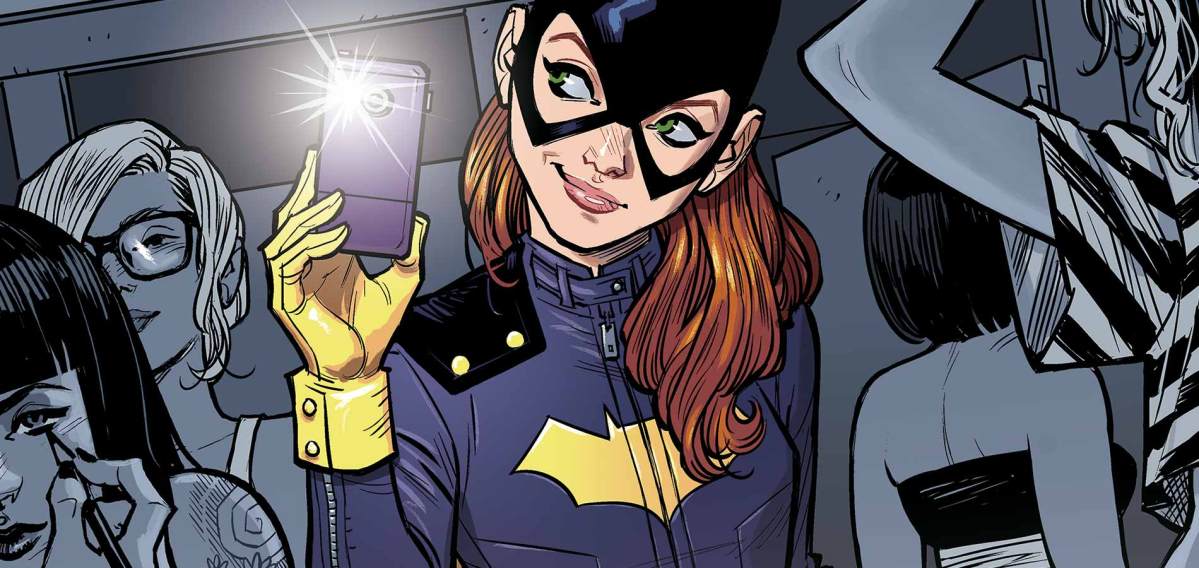It’s been a rough few years for Barbara Gordon since her New 52 reboot in 2011, spearheaded by Gail Simone. As she tries to put her trauma behind her by moving to Gotham’s high end district Burnside, it makes sense to usher in a new creative team for this pivotal stage in her life. Her re-imagined outfit, complete with detachable cape, gives Babs a punky edge, making use of YouTube know-how. Virtually everything’s made easier by the internet, and it’s become second nature to publish our lives online. On one hand, this gives us personal and creative freedoms on incredible levels, and friendships are made that would otherwise have been unlikely. But on the other, with the anonymity and self-perpetuation of online culture, the trolls come out to play.
Batgirl #35 has a through-line of how vulnerable personal information is, once thrown to the mercy of the interwebs. If you happen to get on the wrong side of the wrong person, anyone’s in danger of malicious targeting. And yet, this is seen as less severe than in “real life,” with legislation only beginning to punish those who bully, harass and target others online. There’s a noxious attitude that incidents like “The Fappening,” and the death threats being suffered by game developers and critics, supposedly in the name of ethics, are just the price of being on the internet. In the first pages of #35, it’s suggested that Alysia, Barbara’s former roomie, received a dick pic from Riot Black—villain of the piece and manchild misogynist. The way it’s tossed into conversation reflects how ridiculously commonplace that kind of abuse has become, and this is one of the main issues the book is based around. Cameron Stewart and co. give a dystopian projection of someone who has achieved celebrity status by distributing personal information, still hiding behind a username; a blur between avatar and the (barely) human.
So, beneath the pastel shades and swank of Barbara’s new home, darkness abounds. It’s still Gotham, after all. But within her circle of friends, the positive nature of internet culture comes to the forefront. It’s Hooq, the dating app coded by new roomie Frankie, which, half by happy accident, flushes out a gadget thief working for Riot Black. It makes sense, considering her Oracle years, that Barbara knows how to manipulate tech for detecting and detaining criminals, as with the QR code that staggers Black in the end. It would be great to see her show off more of her digital sleuthing skills. She’s already caught a thief as plain old Babs, and that was while nursing a hangover. It would be a bold move for her to start relying less on the Batgirl persona, with the discretion of the internet providing an alternative layer of cover.
Co-writer Brenden Fletcher has said that “Issue #37… will most certainly deal with Barbara’s feelings about Batgirl being in the spotlight.” A Batgirl imitator appears at the end of #35, reflecting impersonation as a weapon; media critic Anita Sarkeesian named this, along with conspiracy theories, as one of the most conniving means of attack she suffers. So Fletcher might be suggesting that the potential destructive impact of online personas will be explored in future issues. The impersonator in this case knows that Barbara Gordon is Batgirl, so they’re in a position to make an active effort to force her out of the role. Cameron Stewart’s team “wanted to deal with criminals that can’t just be defeated by a punch to the face,” and using internet culture as a breeding ground for more elusive enemies would be sure to take this run into progressive and more relevant directions.
However the story plays out, it’s certain that we’ll be seeing Babs having successes on her own merit, as a young woman, adding credence when she’s in costume. Artist Babs Tarr’s variation in fashion also combats the “all sex, all the time” ideals applied to women across all media. She’s pointed out that “women represented in comics were all wearing the generic comic book heels, skirt and jacket,” and shown that anyone who’s been through the wringer like Barbara has, often feels more like slouching around in a comfy tee and jeans. And, in a sense reprising how Oracle pushed against the marginalisation of women in comics, Frankie’s crutches are shown in her room to signify her muscular disorder. As our efforts for equal representation are pushed against all the way, it’s heartening to see these small but meaningful details, illustrating real, individual women.
Of course, chances are that as long as the internet exists, there will be troubles. But right now, with geek ambassadors like Joss Whedon and Neil Gaiman standing up for feminism, alongside self-starting spokespeople like Anita Sarkeesian, the more realistic twenty-something Batgirl is another on the expanding list of role models for aspiring heroines. Thanks to web culture, we can see fighting the good fight becoming easier and more wide-reaching than ever.
A newly minted Masters student, Elisabeth is a comic collector, sci-fi fancier and hero for hire. Likes: Bjork, boots, pancakes and penguins. Dislikes: kobolds, cool kids, trolls and mild cheddar. You can find her on Twitter @LittleTinMiss.
Are you following The Mary Sue on Twitter, Facebook, Tumblr, Pinterest, & Google +?









Published: Nov 10, 2014 08:00 pm